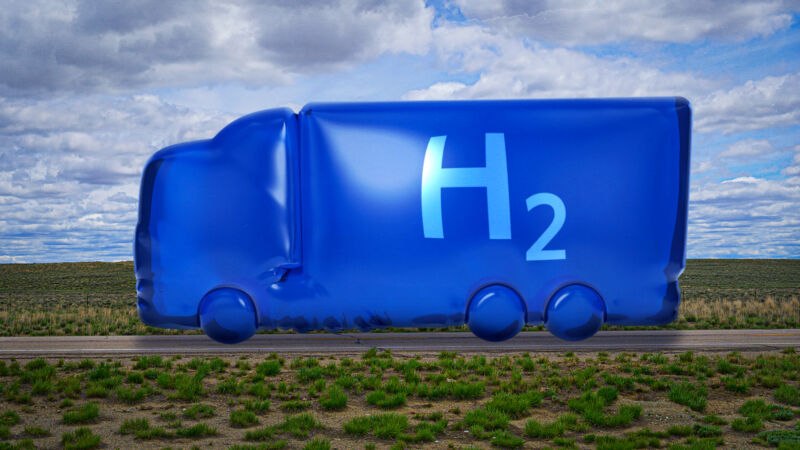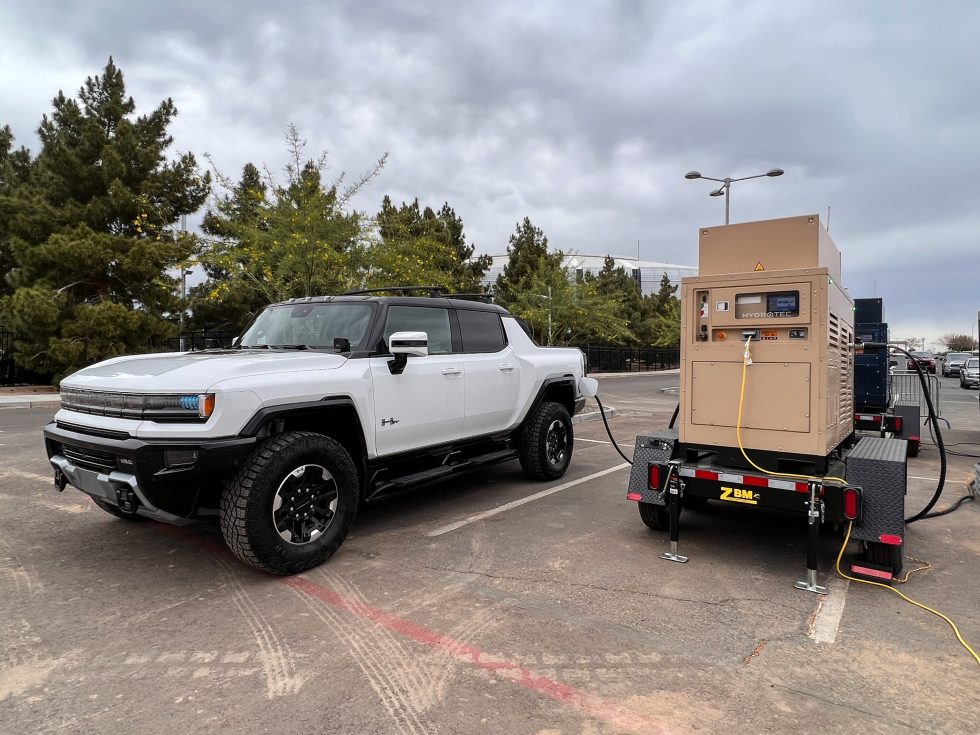Hydrogen is attractive to trucking and ports, but only if it's clean.
JONATHAN M. GITLIN - 4/20/2022,

Aurich Lawson | Getty Images
Earth Day is April 22, and its usual message—take care of our planet—has been given added urgency by the challenges highlighted in the latest IPCC report. This year, Ars is taking a look at the technologies we normally cover, from cars to chipmaking, and finding out how we can boost their sustainability and minimize their climate impact.
You can understand why the idea of a hydrogen-powered car is appealing. Humans aren't great at accepting change, but we do find comfort in the familiar. Being told that our transport must decarbonize means more change. While electric vehicles are better at almost everything, even the world's biggest EV evangelist must concede that charging a car takes longer than filling a fuel tank. Hydrogen can be pressurized and pumped, and hydrogen can be clean, therefore hydrogen-powered cars make sense, the argument goes.
That's probably all the prompt any regular Ars Technica reader needs to list the reasons why hydrogen is a non-starter. Like mammals after the Chicxulub asteroid, battery electric vehicles are poised to fill the niches soon to be left by the dinosaurs, in this case fossil fuel-powered vehicles, leaving alternative fuels like hydrogen evaporating into thin air.
But don't count the universe's simplest molecule out just yet. While it's unlikely to catch on in the near future for light passenger vehicles, there are commercial applications like trucks, trains, and other heavy equipment where it does make sense. (For this entire article, we're talking about green hydrogen, made of wind or solar energy; using fossil fuels to make hydrogen—even with carbon capture—offers little to no benefit. Unfortunately, the vast majority of hydrogen currently produced is derived from hydrocarbons.)
Forget about hydrogen cars—at least for now
There are two main ways to use hydrogen to power a vehicle. You can burn pressurized hydrogen in an internal combustion engine or use the hydrogen in a fuel cell to generate electricity to power electric motors.
Burning hydrogen in an internal combustion engine is probably the most straightforward in terms of existing tech—after modifications to the engine and fuel system, the rest of the car's powertrain remains the same. And the only exhaust product is water. But hydrogen has little energy density, with just a single covalent bond between two atoms to be broken. Hydrogen combustion engines also make little power, and very inefficiently compared to a similar engine burning gasoline.Advertisement
So, BMW's 2006 Hydrogen 7 used a modified version of the company's V12 engine that, burning hydrogen, generated about 60 percent as much power as the gasoline-burning V12 and required five times as much fuel to do so.
Hydrogen fuel cells have a lengthier automotive history: the first was the General Motors Electrovan in 1966, which had a curb weight that would shame even a Hummer EV and used actual space-age technology. By the mid-2010s, automaker interest in fuel cells was surging, with Audi, BMW, GM, Genesis, Honda, Mercedes-Benz, Toyota, and others portending fuel cell EVs in the next few years.
Some even made it into production: Ars tested two generations of Toyota Mirai, and the Hyundai Nexo, all of which use hydrogen fuel cells to power their electric motors. But neither Mirai nor Nexo is common on the roads. Here in the US, neither is viable outside of California, which remains the only state with any level of public hydrogen refueling infrastructure.
Hydrogen's fast refueling times (relative to fast-charging an EV) count for nothing if you can't find a filling station, which has created a chicken-and-egg problem. Without hydrogen fuel cell EVs on the roads, there's no demand for building the infrastructure. And there's no demand for a car or SUV you can't refuel anywhere.
"The challenge doing it for retail customers who have a very different set of needs than, let's say, commercial customers in the aerospace business or in the trucking business or the rail business is they want hydrogen everywhere. They don't know where they're going to want it, but they want it there when they need it, and they don't want the inconvenience or the range anxiety of trying to hunt for hydrogen. And so that means you put in a lot of stations when you don't have a lot of vehicles on the road, and those stations don't operate efficiently," explained Charlie Freese, the head of GM's fuel cell program.
Fixed routes let you plan
It takes a lot less work to build out hydrogen refueling infrastructure if you're on a fixed route or always returning to the same place—like the drayage trucks at the Ports of Los Angeles and Long Beach in California. In 2017, Toyota started testing its fuel cell technology adapted from the Mirai sedan to power a class 8 tractor-trailer. By June 2021, the project expanded to five heavy-duty trucks and plans to add five more, as well as two battery-electric yard tractors.
GM has been looking at trucking as a better fit for its hydrogen fuel cells than another SUV. "We're able to leverage investments that are already going in for hydrogen at factories and at warehouses where forklifts are operating, economically, on hydrogen today. We can use those same refueling points to fuel the trucks," Freese told me.
Frank Weber, a BMW board member with responsibility for new technology, also sees a future for hydrogen fuel cells as a way to electrify heavy vehicles. "Hydrogen is one of the few options to get them to zero emissions. Because a battery-electric heavy truck is a problem. If you have 40 ton and you have to dedicate 10 ton into batteries—wow," Weber exclaimed. "So when you look at the European development, even the Chinese development and the Asian development, it is obvious—We will see infrastructure in mobility for heavy trucks that is hydrogen infrastructure," Weber said.
"So for larger vehicles, fuel cells become a very interesting point. Because with those large batteries, the fuel itself becomes very competitive and with hydrogen being more available and being affordable, when we look at the industrialization of hydrogen, then we can say for large vehicles fuel cells might be an alternative in the future," Weber told Ars.
Fuel cells are an attractive way to electrify rail lines where adding a third rail or catenary is unworkable or cost-prohibitive, and GM is working with train-maker Wabtec to adapt GM's Hydrotec fuel cell platform to power freight locomotives. Hydrogen fuel cells are also candidates for replacing fossil fuel-burning auxiliary power units on aircraft. "We can provide the zero-emission solution, and we can provide improvements in terms of performance—now I can have a system that is optimized, I don't have a compromised turbine that doesn't really want to sit there and run on the ground, but it has to. And I don't have to have the noise that comes along with these big APUs on these aircraft," Freese told me.
Hydrogen is also appealing for applications in places with a complete lack of infrastructure, in addition to reliable fixed routes around places like ports, rail hubs, and airports.

Enlarge / At the recent Hummer EV first drive event, GMC used a number of Hydrotec fuel cell generators to fast-charge the trucks each night between waves of journalists.
Jonathan Gitlin
The fledgling Extreme E off-road racing series travels with its own solar array and electrolyzer, making hydrogen that's used to run generators to charge the electric racing cars.
Anglo American is exploring a similar concept, minus the racing and focus on environmental destruction. It's testing out a hydrogen fuel cell-powered mining truck fueled by hydrogen that's electrolyzed on-site. And the potential to make your own fuel with not much more than water and some solar panels or wind turbines has led to interest from airship developers and marine biologists.
Assuming that hydrogen fuel cells find favor for uses like freight trucking, rail transport, aviation, and other industries, it's possible to see that eventually leading to a second chance for light passenger vehicles powered by hydrogen. I'm just not sure whether the Mirai and Nexo will have faded from memory like the Electrovan before that happens.
JONATHAN M. GITLIN
Jonathan is the automotive editor at Ars Technica, covering all things car-related. Jonathan lives and works in Washington, D.C.EMAIL jonathan.gitlin@arstechnica.com // TWITTER @drgitlin
No comments:
Post a Comment